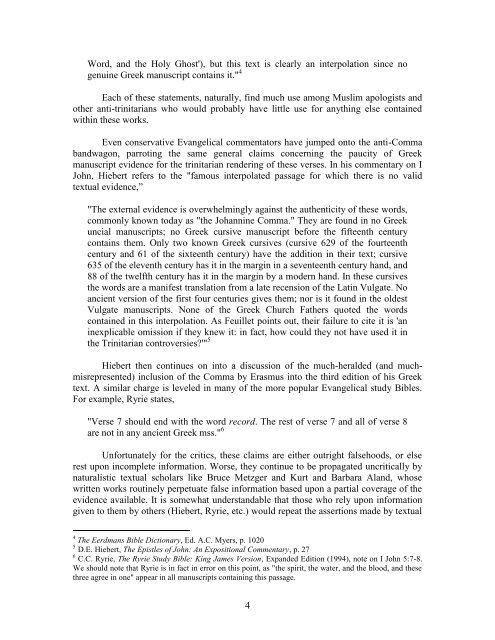A Defense of the Johannine Comma - Study to Answer.Net
A Defense of the Johannine Comma - Study to Answer.Net
A Defense of the Johannine Comma - Study to Answer.Net
Create successful ePaper yourself
Turn your PDF publications into a flip-book with our unique Google optimized e-Paper software.
Word, and <strong>the</strong> Holy Ghost'), but this text is clearly an interpolation since no<br />
genuine Greek manuscript contains it." 4<br />
Each <strong>of</strong> <strong>the</strong>se statements, naturally, find much use among Muslim apologists and<br />
o<strong>the</strong>r anti-trinitarians who would probably have little use for anything else contained<br />
within <strong>the</strong>se works.<br />
Even conservative Evangelical commenta<strong>to</strong>rs have jumped on<strong>to</strong> <strong>the</strong> anti-<strong>Comma</strong><br />
bandwagon, parroting <strong>the</strong> same general claims concerning <strong>the</strong> paucity <strong>of</strong> Greek<br />
manuscript evidence for <strong>the</strong> trinitarian rendering <strong>of</strong> <strong>the</strong>se verses. In his commentary on I<br />
John, Hiebert refers <strong>to</strong> <strong>the</strong> "famous interpolated passage for which <strong>the</strong>re is no valid<br />
textual evidence,”<br />
"The external evidence is overwhelmingly against <strong>the</strong> au<strong>the</strong>nticity <strong>of</strong> <strong>the</strong>se words,<br />
commonly known <strong>to</strong>day as "<strong>the</strong> <strong>Johannine</strong> <strong>Comma</strong>." They are found in no Greek<br />
uncial manuscripts; no Greek cursive manuscript before <strong>the</strong> fifteenth century<br />
contains <strong>the</strong>m. Only two known Greek cursives (cursive 629 <strong>of</strong> <strong>the</strong> fourteenth<br />
century and 61 <strong>of</strong> <strong>the</strong> sixteenth century) have <strong>the</strong> addition in <strong>the</strong>ir text; cursive<br />
635 <strong>of</strong> <strong>the</strong> eleventh century has it in <strong>the</strong> margin in a seventeenth century hand, and<br />
88 <strong>of</strong> <strong>the</strong> twelfth century has it in <strong>the</strong> margin by a modern hand. In <strong>the</strong>se cursives<br />
<strong>the</strong> words are a manifest translation from a late recension <strong>of</strong> <strong>the</strong> Latin Vulgate. No<br />
ancient version <strong>of</strong> <strong>the</strong> first four centuries gives <strong>the</strong>m; nor is it found in <strong>the</strong> oldest<br />
Vulgate manuscripts. None <strong>of</strong> <strong>the</strong> Greek Church Fa<strong>the</strong>rs quoted <strong>the</strong> words<br />
contained in this interpolation. As Feuillet points out, <strong>the</strong>ir failure <strong>to</strong> cite it is 'an<br />
inexplicable omission if <strong>the</strong>y knew it: in fact, how could <strong>the</strong>y not have used it in<br />
<strong>the</strong> Trinitarian controversies?'" 5<br />
Hiebert <strong>the</strong>n continues on in<strong>to</strong> a discussion <strong>of</strong> <strong>the</strong> much-heralded (and muchmisrepresented)<br />
inclusion <strong>of</strong> <strong>the</strong> <strong>Comma</strong> by Erasmus in<strong>to</strong> <strong>the</strong> third edition <strong>of</strong> his Greek<br />
text. A similar charge is leveled in many <strong>of</strong> <strong>the</strong> more popular Evangelical study Bibles.<br />
For example, Ryrie states,<br />
"Verse 7 should end with <strong>the</strong> word record. The rest <strong>of</strong> verse 7 and all <strong>of</strong> verse 8<br />
are not in any ancient Greek mss." 6<br />
Unfortunately for <strong>the</strong> critics, <strong>the</strong>se claims are ei<strong>the</strong>r outright falsehoods, or else<br />
rest upon incomplete information. Worse, <strong>the</strong>y continue <strong>to</strong> be propagated uncritically by<br />
naturalistic textual scholars like Bruce Metzger and Kurt and Barbara Aland, whose<br />
written works routinely perpetuate false information based upon a partial coverage <strong>of</strong> <strong>the</strong><br />
evidence available. It is somewhat understandable that those who rely upon information<br />
given <strong>to</strong> <strong>the</strong>m by o<strong>the</strong>rs (Hiebert, Ryrie, etc.) would repeat <strong>the</strong> assertions made by textual<br />
4 The Eerdmans Bible Dictionary, Ed. A.C. Myers, p. 1020<br />
5 D.E. Hiebert, The Epistles <strong>of</strong> John: An Expositional Commentary, p. 27<br />
6 C.C. Ryrie, The Ryrie <strong>Study</strong> Bible: King James Version, Expanded Edition (1994), note on I John 5:7-8.<br />
We should note that Ryrie is in fact in error on this point, as "<strong>the</strong> spirit, <strong>the</strong> water, and <strong>the</strong> blood, and <strong>the</strong>se<br />
three agree in one" appear in all manuscripts containing this passage.<br />
4


